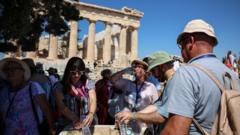To combat the heat, Saudi officials have launched multiple initiatives, including the planting of thousands of trees and the installation of over 400 cooling units around the holy city. They have expanded shaded areas significantly and developed cooled roadways to help reduce heat exposure. Additionally, the Saudi health ministry has issued guidelines urging pilgrims to avoid strenuous outdoor activities during peak sun hours, stay hydrated, and utilize umbrellas for shade.
In light of last year's incidents—whereby the majority of casualties were linked to unregistered pilgrims without access to essential services—the government has imposed strict regulations. This includes banning children under 12 from participating in the Hajj and instituting heavy penalties for those attempting the pilgrimage without proper permits. Over 269,000 individuals were reportedly prevented from entering Mecca as officials strive to ensure crowd control and provide adequate resources for attendees.
The Hajj is a pivotal religious obligation for Muslims, requiring many to save significantly to afford the journey, with packages costing anywhere between $4,000 and $20,000. For some, affordability challenges lead to travel on tourist or visitor visas, which may restrict access to necessary accommodations during the pilgrimage.
As pilgrims gather at the Grand Mosque—Islam's holiest site—esteemed rituals such as tawaf (circumambulating the Kaaba) and sai (walking between the hills of Safa and Marwa) commence. The congregation will head to Mina, where they will spend the night in tents before proceeding to Mount Arafat.
Through cutting-edge technological innovations like artificial intelligence for crowd management, Saudi authorities are committed to preventing tragedies and ensuring a safer pilgrimage experience for all participants in this sacred undertaking.
In light of last year's incidents—whereby the majority of casualties were linked to unregistered pilgrims without access to essential services—the government has imposed strict regulations. This includes banning children under 12 from participating in the Hajj and instituting heavy penalties for those attempting the pilgrimage without proper permits. Over 269,000 individuals were reportedly prevented from entering Mecca as officials strive to ensure crowd control and provide adequate resources for attendees.
The Hajj is a pivotal religious obligation for Muslims, requiring many to save significantly to afford the journey, with packages costing anywhere between $4,000 and $20,000. For some, affordability challenges lead to travel on tourist or visitor visas, which may restrict access to necessary accommodations during the pilgrimage.
As pilgrims gather at the Grand Mosque—Islam's holiest site—esteemed rituals such as tawaf (circumambulating the Kaaba) and sai (walking between the hills of Safa and Marwa) commence. The congregation will head to Mina, where they will spend the night in tents before proceeding to Mount Arafat.
Through cutting-edge technological innovations like artificial intelligence for crowd management, Saudi authorities are committed to preventing tragedies and ensuring a safer pilgrimage experience for all participants in this sacred undertaking.




















